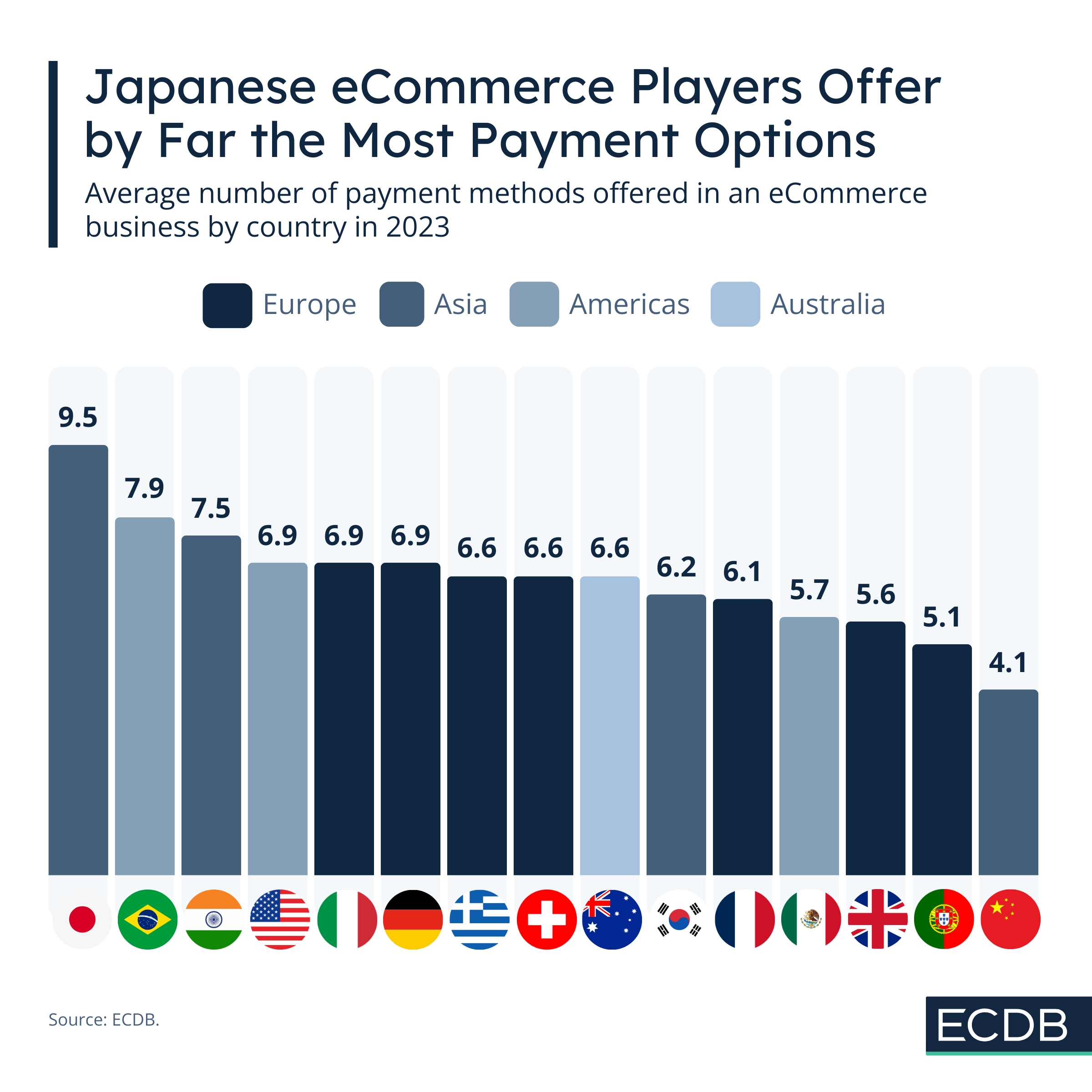China and the U.S. Digitally Minded in Payment: E-Wallets, PayPal, AliPay
PayPal belongs to the pioneers of eWallets as we know them today. Other fintech companies, powered by the biggest in tech, have now caught up.
National Averages in eCommerce Revenue
The number of payment options offered can determine whether an online store is perceived as credible. But what is a good amount of payment methods? Spoiler: it depends on the country.

Antonia Tönnies
Data Journalist
March 17, 2025
Payment

How many and which payment methods an online store offers can determine whether an online store is considered trustworthy. So far the theory In practice, the number of payment options offered in eCommerce varies from country to country. According to our extensive data resources at ECDB, it can range from 4 to more than 9 different options. Likewise, the preference for certain types of payment methods varies.
The countries with the highest average number of payments tend to have a particularly high share of card providers that online stores offer. In particular, two providers, MasterCard and VISA, are jointly offered in markets.
Japan has the highest number with an average of 9.5 payment methods, followed by Brazil with 7.9. Both of these countries stand out for having exclusively cards in their top 5 payment method rankings. One could say that the higher number could be related to a greater variety of cards. First and foremost, VISA and Mastercard are the most offered options with 92.9% and 92.4% in Japan as well as 97% and 96.8% in Brazil.
Generally, both Mastercard and VISA are considered to be on the safe side in all eCommerce markets, particularly in Western countries. Here these two methods often rank among the top 3, mostly together with the U.S. e-wallet PayPal, as is the case in Italy, Germany, Switzerland, France and Australia.
On average, 4.2 payment methods are offered in the Chinese eCommerce market. Among the top 5 payment methods offered, there are fewer cards, but instead more e-wallets such as Ali Pay (57.1%) and WeChat (45.1%).
The South Korean eCommerce market shows a similar pattern, with an average of 6.2 payment methods. Behind the dominant payment method of bank transfer/cash in advance, e-wallets have a strong presence through Kakao Pay, Payco and Naver Pay.
China and South Korea are both markets characterized by strong digitization and correspondingly high online shares. In the year 2024, China ranked first in the world with 27.8% and South Korea fourth with 23.9%.
While South Korea and China stand out for their modern payment methods, other payment options exist and are very popular. More old-fashioned payment methods remain popular in some countries. They are often perceived as more secure by consumers and are used accordingly.
In India, Mexico and Greece, for example, the top 5 payment methods include cash on delivery, which means the consumer pays for a product or service in cash upon delivery. Other countries such as in Greece (77.1%), South Korea (64.1%) and India (60.8%) show a strong preference for bank transfer/cash in advance. Especially in Germany, this method is popular, where 72.3% of German online stores offer bank transfer and 46.6% Sofortüberweisung.
Overall, the differences between eCommerce markets highlight the regional differences in payment preferences. Although, there are also commonalities, as evidenced by the wide coverage of Mastercard and VISA.
Related Articles
PayPal belongs to the pioneers of eWallets as we know them today. Other fintech companies, powered by the biggest in tech, have now caught up.
Scandinavia has the lowest penetration of cash payments in eCommerce, at rates under 10%. Greece, Bulgaria and Slovakia are over 80% cash-friendly in eCommerce. More on the cash gradient here.
PayPal is most offered by online stores in Germany, in the U.S. not so much. The e-wallet performs best in Europe, overall.

Click here for
more relevant insights from
our partner Mastercard.
Our Tool
We’re not just another blog—we’re an advanced e-commerce data analytics tool. The insights you find here are powered by real data from our platform, providing you with a fact-based perspective on market trends, store performance, industry developments, and more.
Analyze retailers in depth with our extensive Retailer dashboards and compare up to four retailers of your choice.
Learn More
Combine countries and categories of your choice and analyze markets in depth with our advanced market dashboards.
Learn More
Compile detailed rankings by category and country and fine-tune them with our advanced filter options.
Learn More
Discover relevant leads and contacts in your chosen markets, build lists, and download them effortlessly with a single click.
Learn More
Benchmark transactional and conversion funnel KPIs against market standards and gain insight into the key metrics of your relevant market.
Learn More
Our reports provide pre-analysed data and highlight key insights to help you quickly identify key trends.
Learn More
Find your perfect solution and let ECDB empower your e-commerce success.